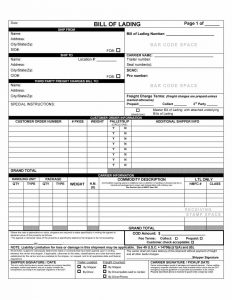The bill of lading (BOL) is one of the most important documents in the shipping industry. It is a legally binding document that provides the driver and carrier all the details needed to process the freight shipment and invoice it correctly. A Bill of Lading has 3 basic purposes or roles.
Evidence of Contract of Carriage
The Bill of Lading acts as evidence of the contract of carriage entered into between the “Carrier” and the “Shipper or Freight Owner” in order to carry out the transportation of the freight as per the contract between the buyer and seller. The BOL must be provided to the carrier when a shipment is picked up, and will be given to the consignee upon delivery.
Receipt of Goods
The Bill of Lading is issued by the carrier or their agent to the shipper or their agent in exchange for the receipt of the cargo. The BOL is proof that the carrier has received the freight in good condition from the shipper or their agent. The shipper should keep a signed copy of the BOL as proof of the carriers liability in the event the shipment is damaged or lost.
Document of title, or ownership of goods.
The Bill of Lading means that the goods may be transferred to the holder of the BOL (the carrier) to be transferred to someone else (the consignee.) However this title varies according to the way the in which the BOL has been consigned. The most common type of BOL is the “Straight Bill of Lading” which is typically used to ship goods to a customer who has already paid for them.
This document also states who is responsible to pay for the freight. It may be:
- Prepaid (Shipper is responsible)
- Collect (Consignee is responsible)
- Bill to a Third Party (as listed is responsible)
The following information must be included in the Bill of Lading
- Shipper & Receiver (consignee) names & complete addresses
- Name of the carrier (Freight Brokers cannot appear on the BOL as the carrier)
- PO or special account number used for order tracking
- Special instructions for the carrier to ensure prompt delivery
- Date of the shipment
- Number of shipping units
- Type of packaging (including cartons, pallets, skids & drums)
- A note if the commodity is a DOT Hazardous Material (Special requirements apply)
- Description of the items being shipped, including the material of manufacture and common name
- Exact weight of the shipment
- Declared value of the goods being shipped
Carriers have the right to inspect, reweigh and reclassify your freight to be sure all weight and shipping class information is accurate. Errors can result in additional charges and delayed delivery of your freight.
The Bill of Lading & Claims
The Bill of Lading is required for all claims for compensation due to damage or loss, and for any disputes regarding ownership of the freight. That is why it is critical that a BOL is filled out correctly at the time of shipment AND when it is received by the consignee. When a consignee accepts receipt of a shipment, they should ALWAYS inspect the shipment and note on the BOL:
- Their signature
- Print their name
- The date and time the items are received
- Any damage or loss
Damage and loss can include a carrier arriving late and causing added rigging costs or plant shut down. Carriers should also note their check in time and check out time for accurate detention time.
Without a correctly completed BOL you could be faced with a major headache should anything go wrong during a freight shipment.
